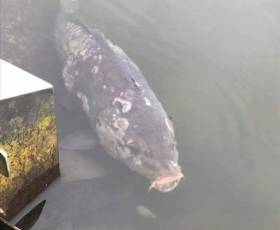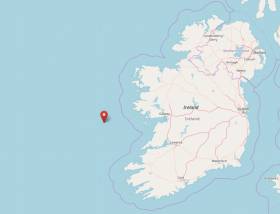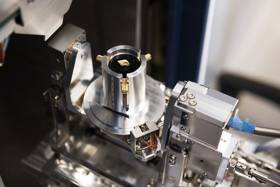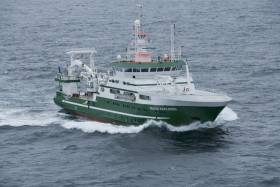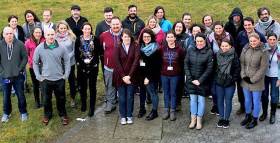Displaying items by tag: Marine Institute
Cork City Fish Kill: Carp Test Positive For Edema Virus
#Angling - Scientists of the Fish Health Unit at the Marine Institute have advised that sample carp taken from The Lough and Belvelly Lake in Cork have tested positive for carp edema virus, or CEV.
The poxvirus causes a disease known as ‘koi sleepy disease’ in both koi and common carp.
The fish kill was first reported at The Lough in Cork city centre last week, with subsequent reports at Belvelly Lake in Cobh. Some 450 carp were removed from the former, and over 20 from the latter, as well as live samples from both for analysis.
At present, while tests are ongoing and further tests are carried out on the CEV detected, this is being treated as a ‘suspect positive’ and is not confirmed as the causative agent of the mortalities until all tests have been completed.
Inland Fisheries Ireland (IFI) recommends that stringent biosecurity protocols continue to be implemented. All mortalities continue to be removed and disposed of in a bio-secure manner.
Angling remains suspended at both locations, as well as at Inniscarra and Carrigadrohid Reservoirs.
Launch of Marine Institute Industry-Led Awards 2018
#MarineScience - The Industry-Led Awards 2018 under the Marine Research Programme has been launched by the Marine Institute.
The Industry-Led Awards funded by the Marine Institute will provide assistance for appropriate research activities that support the goals of Harnessing Our Ocean Wealth and are in the research themes identified in the National Marine R&I Strategy. The Industry-Led call is intended to address a need in the Irish SME sector for funding supports to participate in marine-related research.
The call is designed to provide funding for SMEs to raise the maturity levels for their research themes across these dimensions. The funding is aimed at supporting research and innovation costs for the development of innovative technologies, products and services from existing or new marine-based business. Collaboration with HEIs and other public research bodies is encouraged, but proposals must have an SME lead.
The amount of funding available will be a maximum award amount of €200,000. The total funding available in this call is €2 million. The project must be led by an SME or other commercial entity, academic partners can be involved. The consortium size is a maximum of three partners.
Applications must be made through the Marine Institute's online research grant management system (RIMS). Details on how to register on the system are available in the Guidelines for Applicants. Further information on the call are available in the Guidelines for Applicants and Terms of Reference.
Relevant Dates: Information Days
- Galway - Tuesday, 22nd May 2018
- Dublin - Wednesday 30th May 2018
- Cork - Tuesday, 12th June 2018
Closing Date: 16:00 Thursday 21st June 2018
Registration to attend at an Information Day or requests for further information/clarifications should be addressed to funding [at] marine [dot] ie. Responses to requests for further information/clarifications will be made available to all interested parties via this webpage. Requests for further information/clarifications must be received two weeks before the closing date. Information Days are subject to expressed interest from a minimum of 10 attendees per event.
This research call is funded by the Marine Institute under the Marine Research Programme and also co-funded under the European Regional Development Fund (ERDF) under priority 1 – Strengthening Research, Technology Development and Innovation.
‘Next Generation’ Weather Buoy Set For Testing
#Weather - The Marine Institute is preparing to carry out deployment and extended testing on a next-generation weather buoy from next week.
The ILV Granuaile (Callsign EIPT) will position the data buoy at 53°07.36'N 11°12.00'W. A Statutory Sanction will be in place.
The buoy is a yellow special mark buoy fitted with a yellow light with characteristics FL Y (5) 20 seconds.
Works are scheduled to begin on Monday 7 May and will continue until May 2019.
#MarineScience - A newly commissioned scanning electron microscope will bolster Irish shellfish safety efforts, according to the Marine Institute.
As the designated National Reference Laboratory (NRL) for monitoring marine biotoxins — from outbreaks of phytoplankton blooms, for example — in shellfish production areas, the institute carries out a range of seafood safety programmes.
These ensure that Irish seafood products going to national and international markets adhere to the highest food safety standards.
Joe Silke, manager of the shellfish safety monitoring team, says the new generation of scanning electron microscopes (SEMs) “have been an incredible step forward in microscopic technology.
“Our new instrument offers unrivalled imaging performance and provides high resolution capabilities necessary to observe tiny features on the surface of single celled toxic algae. Placing such samples in the machine will allow us extremely high magnification of these features and certainly opens up a new world of what we can examine and analyse.”
Some 2,750 phytoplankton and 3,000 shellfish samples are tested annually under the national phytoplankton and biotoxin monitoring programmes. This includes weekly testing of shellfish from all production sites as well as weekly seawater sampling and analysis to detect harmful and toxic species.
“The SEM is therefore vital in providing our teams with the ability to identify phytoplankton cells down to species level, and effectively is essential in helping us expand our services,” Silke added.
The microscope will also expand the broader research capabilities of the Marine Institute, with potential applications to marine biodiscovery.
This will include “aiding in as yet to be identified novel organisms and their features, as well as in applied aspects of marine environmental research, such as microplastics for which there is significant current interest,” said Dr Jeff Fisher, director of marine environment and food safety at the Marine Institute.
#MarineScience - As many as 12 artists, writers and musicians from Ireland and Europe have the opportunity to join expeditions on the research vessel RV Celtic Explorer and to work with marine scientists as part of an interdisciplinary art project for radio broadcast.
The three-year AerialSparks project will explore the potential of radio communication as a means to rethink our ocean wilderness as one of the last remaining unknowns.
AerialSparks has been created by artist Louise Manifold for Galway’s European Capital of Culture programme in 2020. Inspired by the concept of traditional broadcasting and the use of sonar and other technology for data collection, the project will result in a series of art works for radio.
Manifold, who previously worked with Galway schoolchildren on marine science and art projects, has commissioned artists from Ireland and Europe to develop new work based on their experiences of spending time at sea on research surveys carried out by the Marine Institute's research vessel, RV Celtic Explorer.
The Galway-born conceptual artist, currently on residency in Berlin, is keen to tap into the connections between radio as a communication and navigation tool, and discover how radio can make spaces visible to audiences.
“While at sea on the Explorer last year, I was extremely mindful of how radio can be listened to in solitude, yet bring people together providing a sense of togetherness,” she said. “It is amazing to think how early radio technology must have felt for many people bridging the distance of the ocean and bringing people together. Recognising the importance of technology, it continues to play a big part in how we understand the influences of the ocean.”
Taking part in the project are renowned artists David Stalling, Kennedy Brown, Carol Anne Connelly and Ailís Ní Riain, who will each spend up to two weeks at sea on the RV Celtic Explorer during scientific expeditions.
One of the surveys, overseen by Prof Andy Wheeler from UCC, includes monitoring deep-water coldwater corals reefs off the continental shelf, exploring the processes involved in understanding the coral habitats and sensitivity to climate change and human impacts.
The artists will have the opportunity to record data where advanced robotic technology and 3D visualisation tools will be used on the ROV Holland I at depths of 3,000m under the water.
Ireland’s offshore territory is 10 times the size of our land area, and marine research projects involving new technology help us learn more about the land under the sea, its geology and processes and how this impacts our lives.
Artists will also get to work with Prof Sergei Lebedev from the Dublin Institute for Advanced Studies (Dias), where research is being conducted looking at offshore earthquakes in the deepest parts of Ireland’s ocean.
With scientific equipment being deployed for the first time from the RV Celtic Explorer, including 18 ocean-bottom seismometers and an array of acoustic sensors, the survey will explore marine activity that can trigger undersea landslides.
Hannah Kiely, chief executive of Galway 2020, said of the project: “We are very excited about the waves of possibilities that the collaboration between arts and science presents particularly given the project’s focus on histories of the ocean voyage, maritime radio communication and how this might be felt and understood in a digital age. With our aim to be the first truly Virtual European Capital of Culture, digital is at the heart of our programme for Galway 2020.”
The ocean covers over 70 percent of the planet’s surface and with the advancement of marine technology, new discoveries are being made every day.
Marine Institute chief executive Dr Peter Heffernan added: “Aerial Sparks is an innovative opportunity for artists and marine scientists to learn new ways to connect and engage with the wider community.
“We are learning more about the ocean including new habitats being explored for the first time, new species being discovered, as well as the effects of climate change and understanding the impacts humans are having on the ocean.
“Therefore, increasing our awareness and narrative about the ocean is extremely important. Using the concept of sound and the sea is a unique way of showing how both the arts and sciences highlight the importance of exploration and curiosity.”
The Marine Institute is also hosting a series of lunchtime talks at its Galway headquarters for scientists, giving them the opportunity to meet artists working on the project, and to be introduced to their ideas, processes and future work for AerialSparks. For further information contact the research operations office at the Marine Institute.
AerialSparks is funded by the Arts Council of Ireland Project Awards, Galway 2020 and the Marine Institute.
#MarineWildlife - Ireland's Deep Atlantic is a new documentary series that airs on RTÉ One this weekend.
Ireland’s Deep Atlantic sees underwater cameraman Ken O’Sullivan embark on a series of voyages out into the open North Atlantic in search of large whales, sharks and cold water coral reefs 3,000 down on Ireland’s deep sea bed.The two-part series explores many of Ireland's sea creatures for the first time, documenting their behaviour, in addition to investigating the health of our deep Atlantic waters.
The Marine Institute was delighted to assist Ken with his expedition to capture this footage.
Speaking about the new series and working with the Marine Institute Ken O’Sullivan said:
" For me as a film maker, and some of the amazing people I’ve been lucky to work with, our ideal is simply to document and create awareness of our incredibly rich oceanic world in Ireland and all around the North Atlantic. By braving the open Atlantic again and again, in ships, sail boats and an open RIB boat, we slowly but eventually encountered some amazing sea life. An enormous group of basking sharks behaving in a way never before documented globally, blue fin tuna feeding alongside dolphins and enormous migrating whales, while in the deep ocean, research scientists brought us and our cameras 3,000 metres down to the sea bed where we documented coral reefs every bit as beautiful and rich in surrounding life as their tropical relatives, all in Ireland. And much more. Irish national research vessel, Celtic Explorer with its ROV submersible in the water.”
Ireland’s Deep Atlantic begins on Sunday, 22nd April at 9.30pm on RTÉ One for more info click this LINK.
Two days later, the Marine Institute is also delighted to welcome Ken O’Sullivan to the Marine Institute's Auditoriumin in Oranmore, Galway on Tuesday 24th April (1.15-2.15pm) for a special screening of the first episode of Ireland’s Deep Atlantic.
#MarineNotice - Hydrographic and geophysical surveys will be undertaken in the Celtic Sea and Atlantic Ocean under the INFOMAR (Integrated Mapping for the Sustainable Development of Ireland’s Marine Resources) programme until October 2018.
Geological Survey Ireland vessels the RV Keary (Callsign EI-GO-9), RV Geo (Callsign EI-DK-6), RV Tonn (Callsign EI-PT-7), RV Mallet (Callsign EI-SN-9) and RV Lir (Callsign EI-HI-2) are already involved in scheduled surveys since March.
Marine Institute vessels the RV Celtic Explorer (Callsign EIGB) and RV Celtic Voyager (Callsign EIQN) will begin surveys this weekend, starting with the former vessel on a three-week survey from Sunday 22 April.
The Celtic Voyager and the Celtic Explorer will be towing a magnetometer sensor with a single cable of up to 200 metres in length. The vessels will display appropriate lights and markers, and will be listening on VHF Channel 16 throughout the course of the surveys.
Details of co-ordinates for these surveys are included in Marine Notice No 18 of 2018, a PDF of which is available to read or download HERE.
Note that the Atlantic Ocean Area may not be surveyed in 2018, but if for operational reasons the survey does take place, it will be during the dates set out above for the Celtic Voyager surveys listed therein. In that event, the Marine Notice will be updated with specific dates.
#MarineScience - A group of transition year students from five counties around Ireland, including Galway, Clare, Mayo, Roscommon and Meath, recently completed a week of marine science and technology training at the Marine Institute.
Now in its fourth year, the Marine Institute transition year training programme is designed to provide students the opportunity to experience what it is like to work in the marine and technology sector.
"Shadowing scientists and staff, the students took part in interactive experiments involving fisheries and ecosystem science, marine environment and food safety, IT applications development, oceanographic research, advanced mapping and research vessel operations as well as, maritime development and communications. The students also took part in a number of fun team building and communications related activities to develop their interpersonal skills. Completing the week with team presentations highlighting their learning from the programme," explained Catherine Quigley-Johnston, HR manager, Marine Institute.
Ireland's marine sector is a vibrant part of our national economy and the need for education in the marine sector at all levels is highlighted by Ireland's Integrated Marine Plan Harnessing Our Ocean Wealth. A recent publication issued by European Commission also noted that in a well-functioning economy, education and industry are two sides of the same coin, where both need to vigilantly highlight the trends in the future job market.
Dr Peter Heffernan, CEO of the Marine Institute said "it is important for the Institute to promote the opportunities in science, technology and innovation, so as to ensure that students are considering on developing the right skills that they need in the future. This is particularly true for the marine economy, where there are brand-new undertakings for marine technology, biotech to traditional ones in the maritime industry including shipping, sectors which are forever evolving".
Combining classroom and workplace experience is a unique opportunity for the transition year students, bridging the gap between sciences and the blue economy. Training such as the Marine Institute's TY Programme, has many advantages as it improves the student's skills and general knowledge about science and the marine environment, sewing the seeds for future careers.
"After a week with our scientists, we can see the students gaining confidence and the motivation to engage with others, highlighting the importance of protecting and sustainably developing our marine resource as well as talking to others about topical world issues such as dealing with ocean plastic pollution at a local and national level," Ms Quigley-Johnston added.
#MarineScience - The Marine Environment and Food Safety (MEFS) team of the Marine Institute has made the list of finalists for the Irish Laboratory Awards 2018.
The MEFS team performs environmental monitoring and related laboratory services managed by four integrated teams to address fish and shellfish health, marine environmental chemistry, shellfish safety and benthic ecology.
“The monitoring, laboratory services and related research we conduct through the MEFS are underpinned by a robust quality management system that ensures our analytical techniques and data management procedures are fit for purpose, providing continued confidence in the accuracy of our data,” says Dr Jeff Fisher, director of marine environment and food safety with the Marine Institute.
With over 40 labs, based at the institute’s headquarters in Oranmore, the team provides continuous year-round technical support and advice to the public, the Government and stakeholders based its laboratory results.
“Our work includes a number of programmes ranging from protecting consumers’ health and ensuring Ireland is in compliance with EU regulations on food safety; to providing diagnostic services and health assessments to ensure fish and shellfish disease events, in cultured or wild stocks, are quickly identified and managed appropriately,” Dr Fisher added.
The team is also involved in conducting environmental monitoring to assess the ecological and chemical status of transitional and coastal waters, as well as maintaining a strong involvement in European and nationally funded research programmes to support delivery of monitoring programmes and advisory services.
Dr Fisher congratulated the team on being shortlisted for the Irish Laboratory Awards. “However it plays out, being nominated is a significant achievement, particularly as it is considered to be a benchmark for those that demonstrate excellence, best practice and innovation in Ireland's laboratories.”
Teams and individuals from across Ireland in a range of fields such as healthcare, agriculture and bio science compete across 22 different award categories. The winners will be announced at a gala event in Dublin’s Ballsbridge Hotel next Thursday 19 April.
2018 Anglerfish & Megrim Survey Begins Today
#MarineNotice - The Marine Institute’s annual Irish Anglerfish and Megrim Survey (IAMS) for 2018 is scheduled to resume today, Tuesday 10 April.
After January's survey off the West and South Coasts, this month's survey will be carried out till Saturday 21 April off the North and North West Coasts of Ireland in fulfilment of Ireland’s Common Fisheries Policy obligations.
The IAMS is a demersal trawl survey consisting of approximately 50 otter trawls of 60 minutes duration in ICES area 6a. Fishing will take place within a three nautical mile radius of the positions indicated in Marine Notice No 15 of 2018, a PDF of which is available to read or download HERE.
Survey operations will be conducted by the RV Celtic Explorer (Callsign EIGB), which will display all appropriate lights and signals during the survey and will also be listening on VHF Channel 16.
The vessel will be towing a Jackson demersal trawl during fishing operations. The Marine Institute requests that commercial fishing and other marine operators keep a three nautical mile area around the tow points clear of any gear or apparatus during the survey period outlined above.
Specifics of any fishing gear or other obstructions that are known and cannot be kept clear of these survey haul locations can be notified using the contact details provided in the Marine Notice.


























